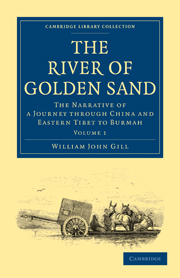Book contents
- Frontmatter
- Contents
- Sketch Map to elucidate recent exploration on the TIBETO-CHINESE FRONTIER
- ILLUSTRATIONS and MAPS to VOL. I
- Errata in Vol. I
- INTRODUCTORY ESSAY
- CHAPTER I ‘OVER THE SEAS AND FAR AWAY’
- CHAPTER II ‘CHINA'S STUPENDOUS MOUND’
- CHAPTER III ‘ATHWART THE FLATS AND ROUNDING GRAY’
- CHAPTER IV ‘A CYCLE OF CATHAY’
- CHAPTER V THE OCEAN RIVER
- CHAPTER VI THE GORGES OF THE GREAT RIVER
- CHAPTER VII CH'UNG-CH'ING TO CH'ÊNG-TU-FU
- CHAPTER VIII A LOOP-CAST TOWARDS THE NORTHERN ALPS
- CHAPTER IX A LOOP-CAST TOWARDS THE NORTHERN ALPS—continued
- Plate section
CHAPTER IV - ‘A CYCLE OF CATHAY’
Published online by Cambridge University Press: 05 March 2012
- Frontmatter
- Contents
- Sketch Map to elucidate recent exploration on the TIBETO-CHINESE FRONTIER
- ILLUSTRATIONS and MAPS to VOL. I
- Errata in Vol. I
- INTRODUCTORY ESSAY
- CHAPTER I ‘OVER THE SEAS AND FAR AWAY’
- CHAPTER II ‘CHINA'S STUPENDOUS MOUND’
- CHAPTER III ‘ATHWART THE FLATS AND ROUNDING GRAY’
- CHAPTER IV ‘A CYCLE OF CATHAY’
- CHAPTER V THE OCEAN RIVER
- CHAPTER VI THE GORGES OF THE GREAT RIVER
- CHAPTER VII CH'UNG-CH'ING TO CH'ÊNG-TU-FU
- CHAPTER VIII A LOOP-CAST TOWARDS THE NORTHERN ALPS
- CHAPTER IX A LOOP-CAST TOWARDS THE NORTHERN ALPS—continued
- Plate section
Summary
The birthplace of the Chinese nation is veiled in mystery. Mr. Douglas, in an exceedingly interesting article in the ‘Encyclopædia Britannica,’ observes: ‘Some believe that their point of departure was in the region to the south-east of the Caspian Sea, and that, having crossed the head waters of the Oxus, they made their way eastward along the southern slopes of the Teen Shan. But, however this may be, it is plain that as they journeyed they struck on the northern course of the Yellow River, and that they followed its stream on the eastern bank, as it trended south, as far as Tung-Kwan, and that then, turning with it due eastward, they established small colonies on the fertile plains of the modern province of Shan-se.’
Mr. Douglas also states that the nucleus of the nation ‘was a little horde of wanderers roving amongst the forests of Shan-se without homes, without clothing, without fire to dress their victuals, and subsisting on the spoils of the chase eked out with roots and insects.’
There were aborigines already here; but of them little is known; their remnants are said to exist at the present day amongst the Miau-Tzŭ of Kwei-Chou.
But the Chinese were the better race; they were also apparently already agriculturists, and as such in a higher state of civilisation.
- Type
- Chapter
- Information
- The River of Golden SandThe Narrative of a Journey through China and Eastern Tibet to Burmah, pp. 139 - 171Publisher: Cambridge University PressPrint publication year: 2010First published in: 1880



